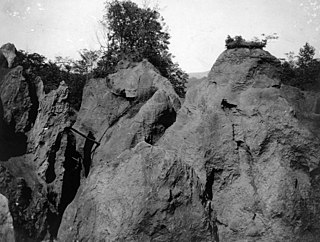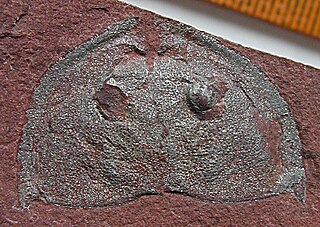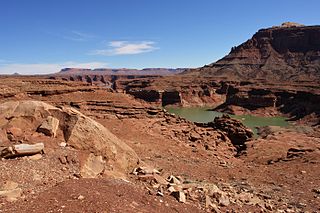
The Tomstown Dolomite or Tomstown Formation is a geologic formation in Maryland, Pennsylvania, Virginia and West Virginia. It preserves fossils dating to the Cambrian Period.

The Everton Formation is a geologic formation in northern Arkansas that dates to the middle Ordovician Period. Unconformities separate this formation from the underlying Powell Formation and the overlying St. Peter Sandstone Formation. Named for the town of Everton in Boone County, Arkansas in 1907, the Everton Formation is composed primarily of dolomite, limestone, and sandstone.

The Wreford Limestone is a geologic formation in Kansas. It preserves fossils dating back to the Permian period.

The Langston Formation is a geologic formation in Idaho and Utah. It preserves fossils dating back to the Cambrian period. The formation is composed of bluish-gray limestone, weathering to a buff color, often with rounded edges.

The Notch Peak Formation is a geologic formation in Utah. It preserves fossils dating back to the Cambrian period.
The Ute Limestone is a geologic formation in Utah. It preserves fossils dating back to the Cambrian period.

The Weeks Formation is a geologic formation in Utah. It preserves fossils dating back to the Cambrian period and more specifically the Guzhangian stage. Its upper part has yielded a diverse fauna dominated by trilobites and brachiopods, but also comprising various soft-bodied organisms, such as Falcatamacaris. As such, it is regarded as a Konservat-Lagerstätte.
The Ely Limestone is a geologic formation in Nevada and Utah. It preserves fossils dating back to the Carboniferous period.
The Great Blue Limestone is a geologic formation in Utah. It preserves fossils dating back to the Carboniferous period.

The Honaker Trail Formation is a geologic formation in Utah. It preserves fossils dating back to the Carboniferous period.
The Wahwah Limestone is a geologic formation in Utah. It preserves fossils dating back to the Ordovician period.
The House Limestone is a geologic formation in Utah. It preserves fossils dating back to the Ordovician period.
The Juab Limestone is a geologic formation in Utah. It preserves fossils dating back to the Ordovician period.
The Fillmore Limestone is a geologic formation in Utah. It preserves fossils dating back to the Ordovician period.
The Virgin Formation is a geologic formation in Utah. It preserves fossils dating back to the Triassic period.
The Thaynes Group, Thaynes Formation in older literature, is a geologic group in eastern Idaho, western Wyoming, Utah and eastern Nevada. It includes the Sinbad Formation, Virgin Formation and Shnabkaib Formation. The Thaynes Group is of marine origin. Its formations are interbedded with layers of the non-marine Moenkopi Group.
The Cowlitz Formation is a geologic formation in Washington (state). It preserves fossils dating back to the Paleogene period
The Swasey Limestone is a geologic formation in Utah. It preserves fossils dating back to the Cambrian period.
The Scremerston Formation is a geologic formation in England. It preserves fossils dating back to the Carboniferous period.
The Weißjura Formation is a Limestone geologic formation located in the Swabian Jura range, Baden-Württemberg, Germany.







